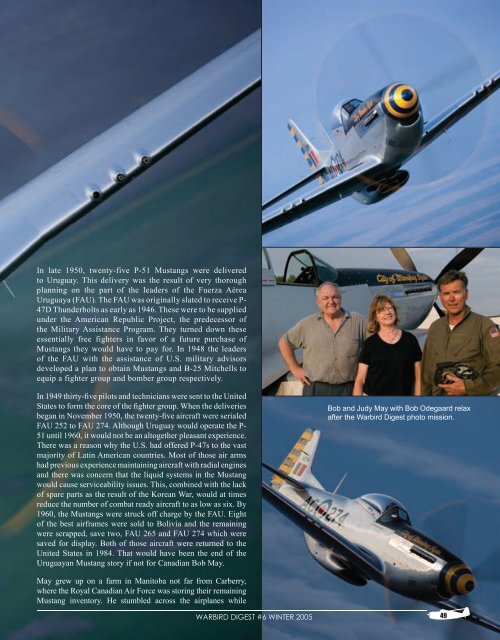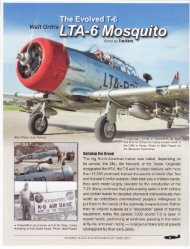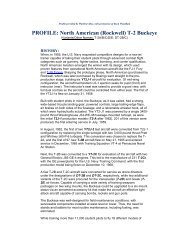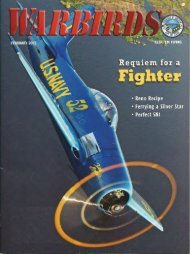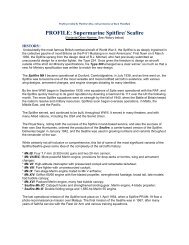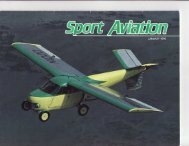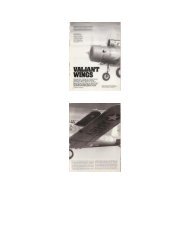to view Warbird Digest's Article on this ... - Courtesy Aircraft
to view Warbird Digest's Article on this ... - Courtesy Aircraft
to view Warbird Digest's Article on this ... - Courtesy Aircraft
You also want an ePaper? Increase the reach of your titles
YUMPU automatically turns print PDFs into web optimized ePapers that Google loves.
In late 1950, twenty-five P-51 Mustangs were delivered<br />
<str<strong>on</strong>g>to</str<strong>on</strong>g> Uruguay. This delivery was the result of very thorough<br />
planning <strong>on</strong> the part of the leaders of the Fuerza Aérea<br />
Uruguaya (FAU). The FAU was originally slated <str<strong>on</strong>g>to</str<strong>on</strong>g> receive P-<br />
47D Thunderbolts as early as 1946. These were <str<strong>on</strong>g>to</str<strong>on</strong>g> be supplied<br />
under the American Republic Project, the predecessor of<br />
the Military Assistance Program. They turned down these<br />
essentially free fighters in favor of a future purchase of<br />
Mustangs they would have <str<strong>on</strong>g>to</str<strong>on</strong>g> pay for. In 1948 the leaders<br />
of the FAU with the assistance of U.S. military advisors<br />
developed a plan <str<strong>on</strong>g>to</str<strong>on</strong>g> obtain Mustangs and B-25 Mitchells <str<strong>on</strong>g>to</str<strong>on</strong>g><br />
equip a fighter group and bomber group respectively.<br />
In 1949 thirty-five pilots and technicians were sent <str<strong>on</strong>g>to</str<strong>on</strong>g> the United<br />
States <str<strong>on</strong>g>to</str<strong>on</strong>g> form the core of the fighter group. When the deliveries<br />
began in November 1950, the twenty-five aircraft were serialed<br />
FAU 252 <str<strong>on</strong>g>to</str<strong>on</strong>g> FAU 274. Although Uruguay would operate the P-<br />
51 until 1960, it would not be an al<str<strong>on</strong>g>to</str<strong>on</strong>g>gether pleasant experience.<br />
There was a reas<strong>on</strong> why the U.S. had offered P-47s <str<strong>on</strong>g>to</str<strong>on</strong>g> the vast<br />
majority of Latin American countries. Most of those air arms<br />
had previous experience maintaining aircraft with radial engines<br />
and there was c<strong>on</strong>cern that the liquid systems in the Mustang<br />
would cause serviceability issues. This, combined with the lack<br />
of spare parts as the result of the Korean War, would at times<br />
reduce the number of combat ready aircraft <str<strong>on</strong>g>to</str<strong>on</strong>g> as low as six. By<br />
1960, the Mustangs were struck off charge by the FAU. Eight<br />
of the best airframes were sold <str<strong>on</strong>g>to</str<strong>on</strong>g> Bolivia and the remaining<br />
were scrapped, save two, FAU 265 and FAU 274 which were<br />
saved for display. Both of those aircraft were returned <str<strong>on</strong>g>to</str<strong>on</strong>g> the<br />
United States in 1984. That would have been the end of the<br />
Uruguayan Mustang s<str<strong>on</strong>g>to</str<strong>on</strong>g>ry if not for Canadian Bob May.<br />
Bob and Judy May with Bob Odegaard relax<br />
after the <str<strong>on</strong>g>Warbird</str<strong>on</strong>g> Digest pho<str<strong>on</strong>g>to</str<strong>on</strong>g> missi<strong>on</strong>.<br />
May grew up <strong>on</strong> a farm in Mani<str<strong>on</strong>g>to</str<strong>on</strong>g>ba not far from Carberry,<br />
where the Royal Canadian Air Force was s<str<strong>on</strong>g>to</str<strong>on</strong>g>ring their remaining<br />
Mustang inven<str<strong>on</strong>g>to</str<strong>on</strong>g>ry. He stumbled across the airplanes while<br />
WARBIRD DIGEST #6 WINTER 2005<br />
49


